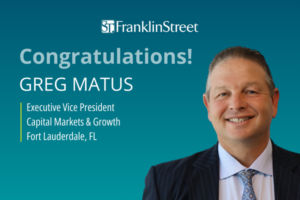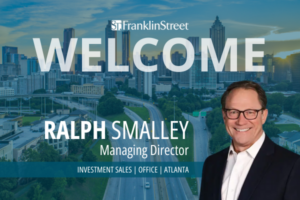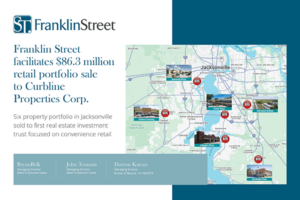Bridge lending “creates an opportunity for an experienced developer to acquire the asset at a good price, turn it around and divest or acquire permanent financing,” explained Steve Bennett, Senior Director Loan Originator of Franklin Street Capital Advisors. “A bridge loan structure will allow thBridge lending “creates an opportunity for an experienced developer to acquire the asset at a good price, turn it around and divest or acquire permanent financing,” explained Steve Bennett, Senior Director Loan Originator of Franklin Street Capital Advisors. “A bridge loan structure will allow the owner to maximize leverage, take cash out for renovations and capitalize interest if the asset doesn’t produce cash flow.”
Banks typically don’t want high-risk properties on their books, which makes conventional lending hard to get. Additionally, banks often can’t underwrite a property fast enough to beat the foreclosure clock ticking on some of these assets.
“For most of these properties, the loan-to-value ratio is high, the risk is usually high and they are typically non-recourse to the borrower. These factors make them non-starters for most commercial banks,” Bennett said.
According to Salvatore M. Buscemi, Managing Director of Dandrew Partners, LLC, and author of Making the Yield: Hard Money Lending Uncovered, bridge lenders see the potential value in distressed properties, whereas banks prefer stabilized properties.
Banks, Buscemi explained, sell their loans to life insurance companies and pension funds. “The last thing those companies want is to deal with having a loan that’s being paid off very quickly,” he said. “They are looking for longevity.”
Investors backing banks don’t want to risk writing loans on properties with an indeterminate term and success probability. “These rehab properties have risk. You don’t know if the key event is going to happen,” Buscemi said. “That’s why private lending has always been there. It is more expensive, but it’s the access to capital that’s important not the price of capital that you are paying for.”
Unlike commercial banks, bridge lenders hold the loans on their balance sheets, Buscemi explained. This business model enables them to evaluate the deal and the borrower, not just the property.
“Bridge lenders don’t care if there are bumps on the credit. They care about his experience because bad operators turn good deals into bad ones, and good operators turn bad deals into good ones,” Buscemi said, adding that bridge lenders have the ability to verify that the borrower is “buying right” and will be able to get the rents or sale price he needs after the renovation.
“They are going to do their due diligence for the surrounding area to make sure they get full value, and that it’s achieved and they’re insulating themselves from the risk,” Buscemi said.
Because bridge lenders specialize in loans with high-risk collateral, it is imperative they have a deep understanding of the surrounding market and confidence in the operator’s ability to complete the project on time and on budget.
“Lenders underwrite with the assumption that they will own this asset, but the last thing they want is to take over a big renovation that turns into a financial black hole,” Bennett said.
Bridge loans not only provide developers with the ability to seize money-making opportunities, they are essential to the economic development within distressed communities.
“The capital invested in a property’s renovation and turnaround can have a big economic impact on the surrounding community,” Bennett said. “A bridge loan structure gives that developer the flexibility to implement a plan over a reasonable period of time.”
Buscemi described another popular area of bridge lending as “9-1-1 loans,” when borrowers hold existing commercial loans that are nearing maturity and they need funds to satisfy the original loan.
“They are coming in close and hard against that wall of default,” he said. “They’ll come to a fund like ours or another bridge lender to get the bridge loan in order to buy off some time so they can pay off one lender while they search and shop around for a permanent lender—usually a life company or a bank—so they can breathe a little easier for a period of a year or two years.”
These attractive, short-term loans also have their place in new development. Prior to the recession, Bennett explained, many new construction deals “had a shorter ‘mini-perm’ loan structure that capitalized interest during construction and gave the property a couple of years to stabilize before being sold or refinanced with permanent debt. Lenders were buying in to pro-forma financial projections that were too optimistic and never panned out.”
Today, as both new and rehab projects are once again exploding in many markets around the country—multifamily properties being particularly popular—new bridge lenders are flocking into the niche, hoping for a piece of pie.
“The industry right now is getting overbanked,” Buscemi said. “There’s now conventional financing to take out these bridge lenders. Bridge lenders are short-term. When you have the conduit lenders and the life companies all of a sudden opening their wallets and getting more aggressive making loans, what happens is that there’s a certainty of an exit strategy for bridge lenders.”
As exit loans from conventional banks become more reliable, and with the influx of new lenders, bridge lending is becoming increasingly competitive. Loan-to-value ratios are getting pushed higher, with some less scrupulous lenders offering 100-percent LTV as they vie for the points—immediate profits—that come with writing loans.
“People are getting a lot more aggressive. When you start to see the top of this is when lenders start underwriting off of the pro-forma NOI, because the pro-forma is basically a made up number. That’s when you are going to see a lot of trouble,” Buscemi said.
“New bridge lending platforms are being created every week,” Bennett added, “and they are all chasing the same deals. Most of these are backed by private equity and they have a limited time frame to get that money out the door, which can lead to bad decisions. As a result, we are starting to see some deals get done that were a non-starter six months ago.”
Despite the risks, bridge lending is essential for getting capital out to the streets. One of the greatest challenges right now, Buscemi explained, is the strict regulatory environment under Democratic leadership that has become suffocating for some developers. There’s widespread belief, he added, that if we see a Republican president in 2016, regulations will loosen, making it easier for bridge lenders and developers to get money into communities in a meaningful way.
While presidential election cycles always bring an uncertainty and volatility to economic forecasting, Bennett was confident that bridge lending will remain strong for the coming year. The key to successful lending is to look at the leverage critically and cynically and to avoid letting emotions and greed interfere with decisions. “The risks are always more asymmetric than they appear,” Buscemi cautioned, adding that when done right, “Private capital always will be the single strongest force during any sort of economic recovery. Always.”e owner to maximize leverage, take cash out for renovations and capitalize interest if the asset doesn’t produce cash flow.”



